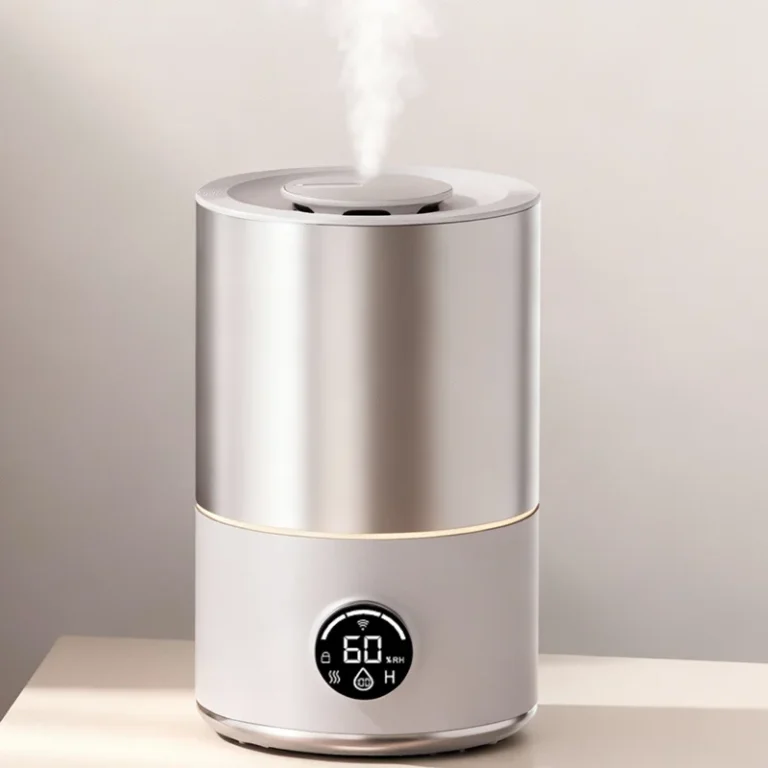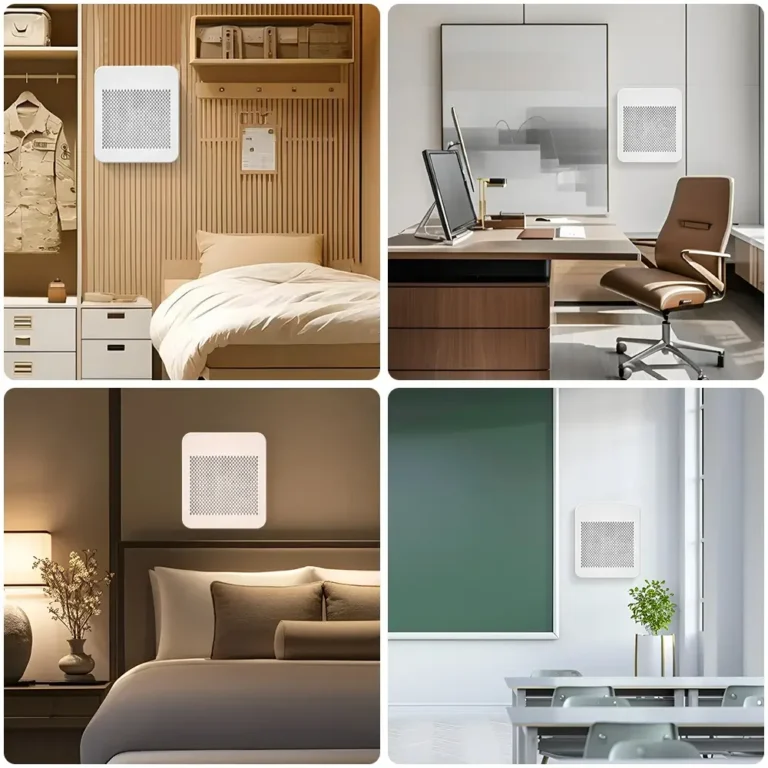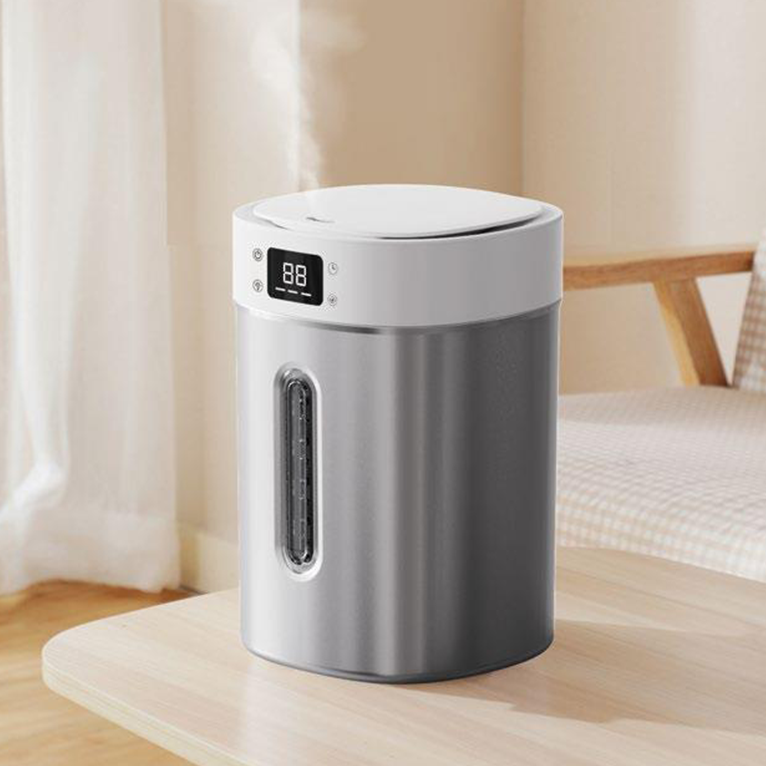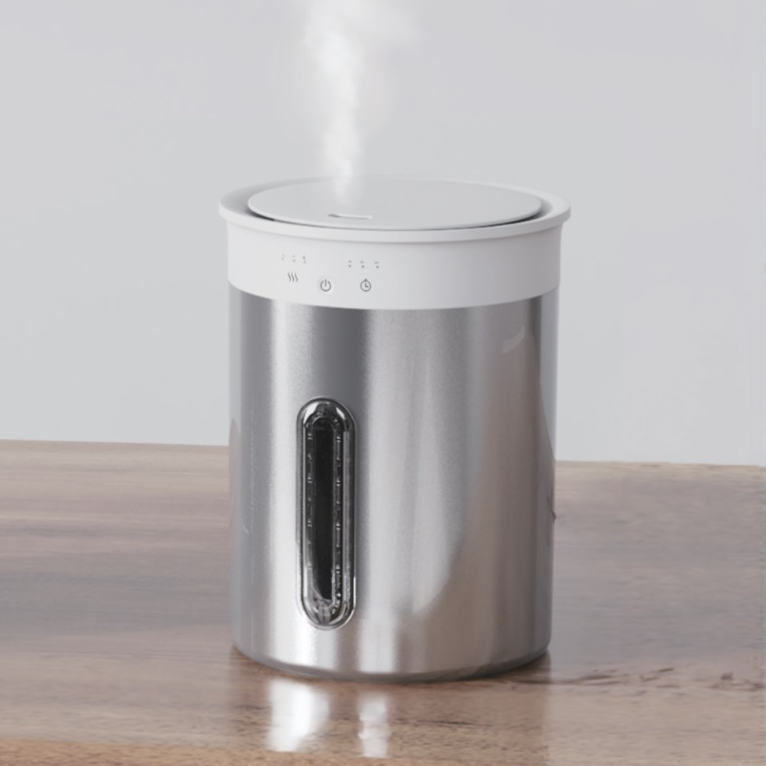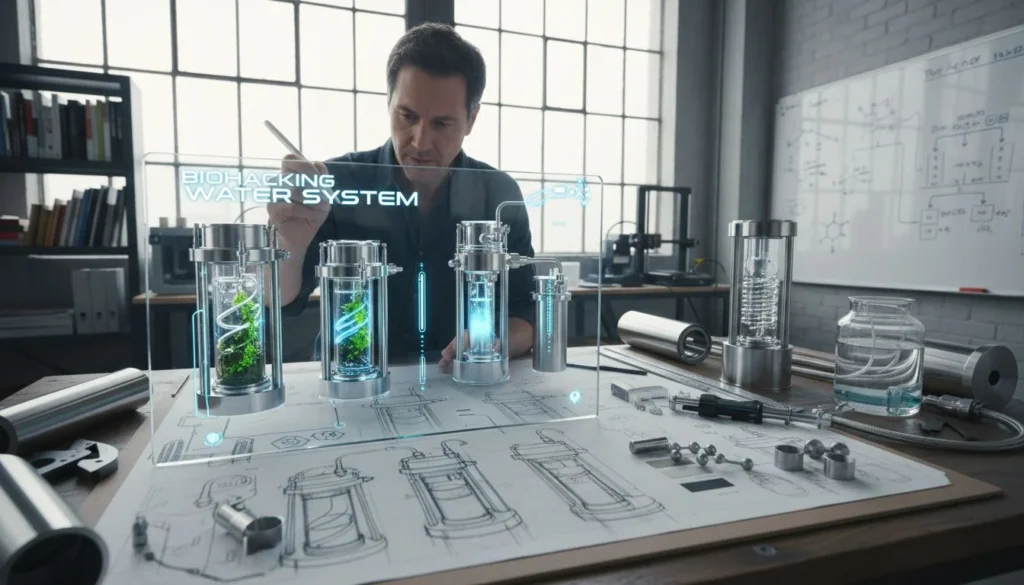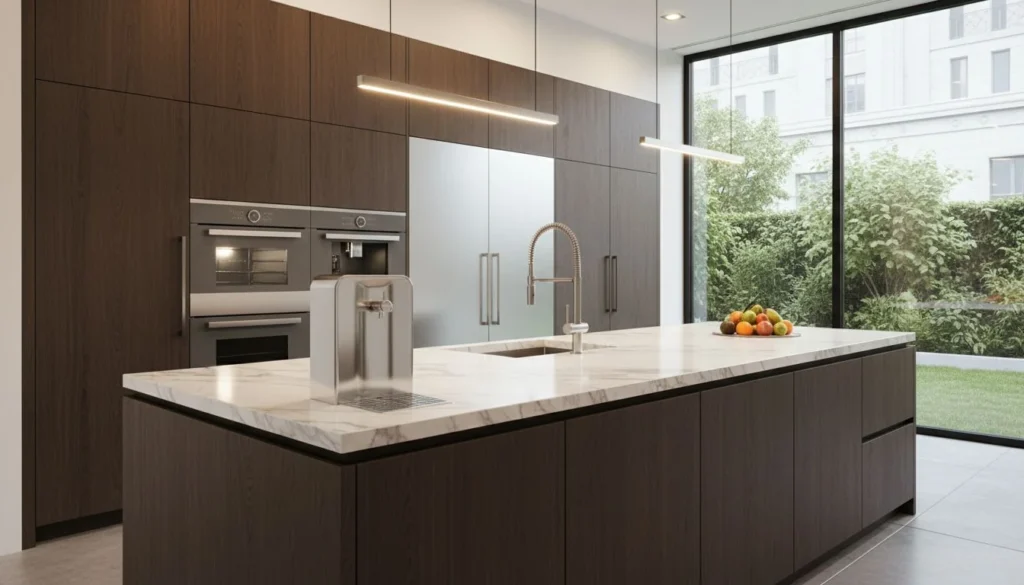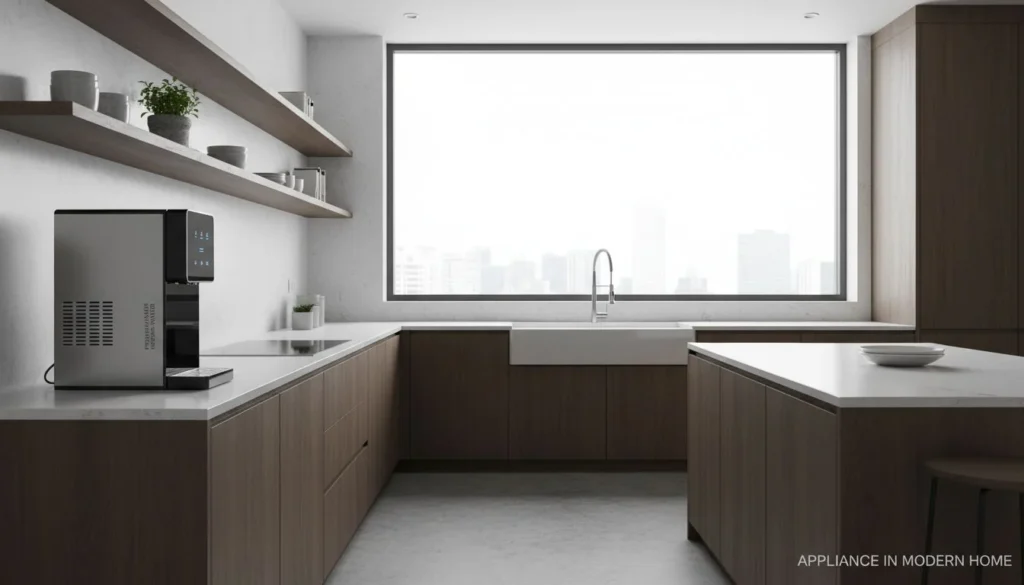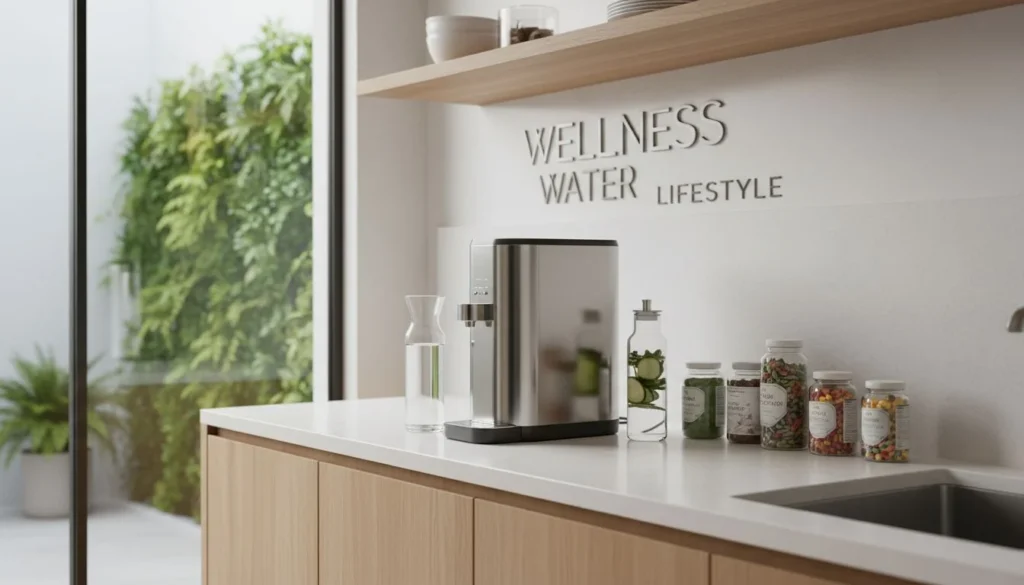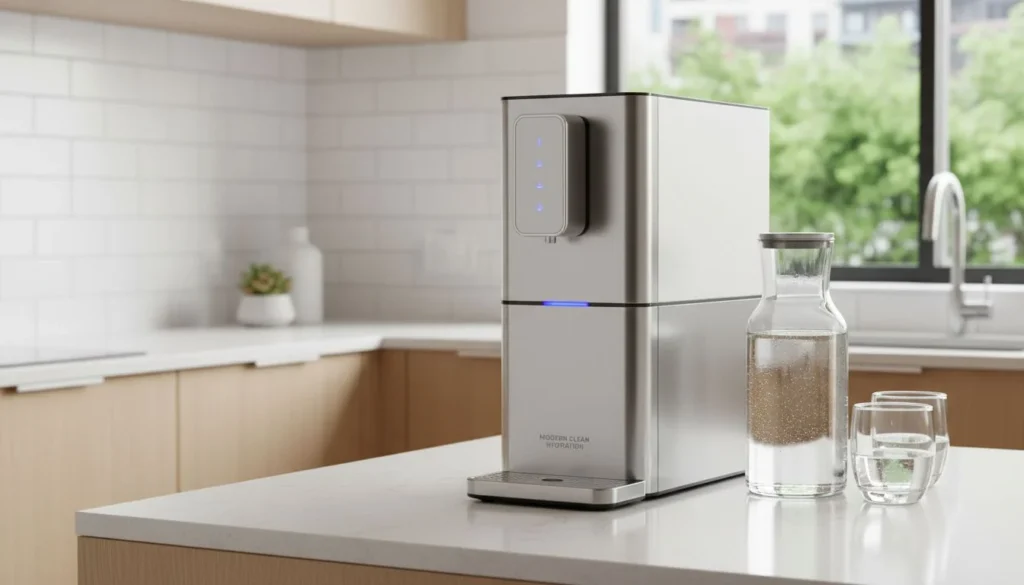加湿器と空気清浄機が家の中で一緒に働くとどうなるか、考えたことがあるだろうか?
加湿器は、空気清浄機が清浄する必要のある粒子を空気に取り込むことで、空気清浄機に影響を与えることがよくある。これは空気清浄機の効果を低下させる可能性がある。特に超音波加湿器は、水道水を使用するとミネラルダストを放出する傾向があります。適切な加湿器を選べば、こうした問題を防ぐことができるかもしれません。加湿器選びは重要です。
自宅で初めて加湿器と空気清浄機の両方を使ったときのことを覚えている。ようやく乾燥した空気とホコリに打ち勝った気がした。その時、奇妙なことが起こった。空気清浄機のセンサーが、空気の質が悪いことを示す赤を示したのだ。超音波加湿器が微粒子を放出し、空気清浄機がその微粒子と格闘していたのだ。
私は、これらの機器がどのように連動しているのかについてもっと学ぶことにした。間違ったセットアップをすると、室内の空気の質が徐々に損なわれる可能性があるからだ。でも心配しないでください!蒸発式加湿器を選べば、この問題を大幅に軽減できます。このオプションは、空気清浄機の機能に影響を与えることなく、より健康的な選択肢を提供します。これらの技術がどのように変化し、スムーズに調和し、問題なく楽に呼吸できるようになったかを見てみましょう。
超音波加湿器は空気の質を悪化させる。真
超音波加湿器は、空気品質の測定値に影響を与える粒子を発生させます。
蒸発式加湿器は有害な粒子を発生させます。偽
気化式加湿器は微粒子を発生させないため、空気の質が向上します。
どのようなタイプの加湿器が空気清浄機と併用するのに最適ですか?
快適で健康的な室内空間を作るには、空気清浄機と一緒に使う加湿器を正しく選ぶことが重要です。どの加湿器が最も効果的かを見極めることが重要です。
気化式加湿器は空気清浄機と相性が良い。空気の質を害する粒子を放出しません。水分は蒸発によって広がります。このプロセスにより、空気は清潔で健康的な状態に保たれます。

加湿器の種類
冬になるとくしゃみがよく出るようになった。そして、正しい加湿器を選ぶことが重要だと気づきました。間違った加湿器は、家に汚染をもたらす可能性がある。空気清浄機に合う加湿器が欲しい場合、以下のことを理解する必要があります:
- 超音波加湿器: これらは非常に静かで、エネルギー消費も少ない。ただし、水道水には注意が必要だ。小さなミネラル粒子が空気中に舞い上がり、空気清浄機を混乱させるかもしれない。 Models like HisoAir HM2206 そして HM618 solve part of this challenge with stainless steel tanks. Stainless steel resists bacterial growth, is easier to sanitize than plastic, and provides a more hygienic experience. When paired with distilled water, these ultrasonic humidifiers deliver clean, comfortable moisture without overloading your air purifier.
- 蒸発式加湿器: 空気清浄機との相性は抜群だ。空気は濡れた芯を通り、悪い粒子を加えることなく空気中に水分を入れる。 The HisoAir HM300 is designed with this in mind. As an evaporative humidifier, it produces particle-free moisture, making it the perfect companion for families with asthma or allergies who rely on their air purifiers to maintain clean indoor air.
| タイプ | メリット | 欠点 |
|---|---|---|
| 超音波 | 静かな動作、エネルギー効率 | 空気中にミネラルを放出する可能性がある |
| 蒸発式 | パーティクルフリーモイスチャー、清浄機対応 | 一般的に大きく、メンテナンスが必要な場合がある |
蒸発式加湿器を選ぶ理由
私は蒸発式加湿器を信頼しています。室内の空気を新鮮で清潔に保つのに役立ちます。この加湿器は、私の部屋の空気を汚すような小さな粒子を放出しません。 空気清浄機1.これは、あなたの家族の誰かが持っている場合、非常に重要である。 喘息またはアレルギー2.加湿器が有害な微粒子を持ち込むことなく、安心して使用できる。
最初のうちは購入費用が高くつくかもしれない。しかし、よりクリーンな空気による快適さと健康は、その費用に見合うだけの価値がある。現在では、家を快適かつ健康に保つ必要性を考える人が増えている。
先進のソリューションとトレンド
今日のテクノロジーは、加湿と空気清浄の両方を行うシステムを提供している。1台の装置で両方を行うのだ。このような加湿器は ヒソエア3 は実に印象的だ。現在の空気の状態に応じて調整し、スペースを節約し、さまざまな装置を使いこなすことなく空気の質をうまく管理する。
環境衛生に対する人々の意識が高まるにつれ、スマート・ソリューションへの投資が重要になっている。このようなイノベーションが成長し、家庭での快適さと健康が改善されるのを見るのは、とてもエキサイティングなことです。次の家電製品を選ぶ際には、具体的なニーズと、これらの新技術がどのように健康的な生活空間をサポートするかを考えてみてください。
その他の考慮事項
- メンテナンス バクテリアの繁殖を防ぎ、ミネラルの蓄積が加湿器や健康に影響を与えないようにするには、定期的な清掃が重要です。 The HisoAir's stainless steel design makes this easier by preventing bacteria buildup in the tank.
- 水質: 超音波式の場合、ミネラル排出を抑えるために蒸留水や脱塩水を使う必要があるが、蒸発式はこの問題を完全に回避できる。
加湿器と空気清浄機を組み合わせる際には、このような細かい点にも気を配り、空気の質や健康を犠牲にすることなく、楽に呼吸できるようにしましょう。
超音波加湿器は空気の質を悪くする。真
超音波加湿器は、空気の質を悪化させる粒子を放出する可能性があります。
蒸発式加湿器は有害な粒子を発生させます。偽
気化式加湿器は粒子を放出しないため、空気の質が向上します。
加湿器は空気清浄機にカビを発生させますか?
加湿器と空気清浄機を同時に使おうと思ったことはありますか?もしかしたら、それは必ずしも有益ではないかもしれません。
加湿器は空気清浄機のカビ繁殖につながる可能性がある。過剰な湿気は、湿った環境を作り出す可能性がある。カビの胞子は湿気の中で成長します。これを防ぐには、適切なメンテナンスを行いましょう。蒸発式加湿器を検討してみてください。おそらく余分な湿気のリスクを下げるでしょう。重要なことです。
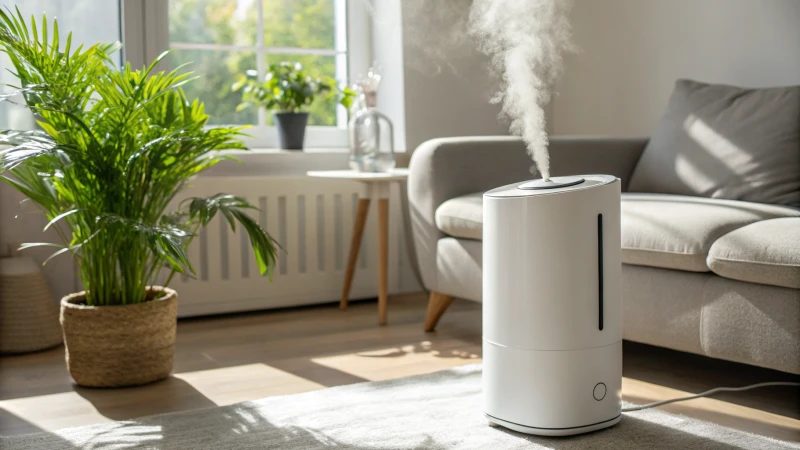
加湿器と空気清浄機との関係を理解する
家の空気が乾燥しすぎていると感じたことはないだろうか。そんな時、"空気清浄機と一緒に加湿器を使ったらどうだろう?"と思う。完璧な組み合わせに見えるでしょう?しかし、ここで驚かされるのは、どの加湿器も同じというわけではなく、中にはかなり厄介なものもあるということだ。超音波式加湿器を試したところ、空気清浄機に入り込むような小さな水滴が噴霧された。やがて私は、清浄機がカビの歓迎スポットになっていることに気づいた。
カビの危険性を認識する
最初のうちは、頭の片隅でうっとうしく思っていただけだった。しかし間もなく、くしゃみが頻繁に出るようになり、アレルギーが悪化した。そして私は気がついた。カビは厄介なだけでなく、大きな健康リスクをもたらす。吸い込むと カビの胞子4 呼吸に影響を与え、喘息やアレルギーを悪化させる可能性がある。より快適な住まいを手に入れようとしているのに、健康上の問題を望む人はいない。適切な湿度レベルのバランスをとることが、私の新しい仕事となった。
カビを防ぐ簡単な方法
私の解決策は?蒸発式加湿器に変えたんだ。本当に大きな違いだ!超音波式加湿器とは対照的に、超音波式加湿器は清浄機内に水を蓄積させる粒子を送らない。また、メーカーのアドバイスに従ってフィルターの掃除と交換を日課にした。私のように、これらの作業を遅らせるのは普通のことだと感じるが、信じてほしい。私の機器周辺を乾燥させておくことは、かなり役に立っている。
簡単な比較表だ:
| 特徴 | 超音波加湿器 | 蒸発式加湿器 |
|---|---|---|
| 粒子放出 | はい | いいえ |
| 空気清浄機におけるカビのリスク | 高い | 低い |
| メンテナンスの必要性 | 高い | 中程度 |
コンバインド・エア・システムの進歩
室内における空気の質への関心が高まる中、テクノロジーの未来は明るい。私は、空気清浄機と蒸発式加湿器を融合させた複合システムをリードするHisoAirのようなブランドを発見した。空気の質と湿度レベルに応じて適応するガジェットを思い浮かべてほしい!カビの心配を軽減し、新鮮な空気を楽しむことができる。どのようなものなのか、興味津々である。 ヒソエアの技術5 私の、そしておそらくあなたの一日の一部になるかもしれない。
これらの機器がどのように連動するのかを学ぶことは、私にとって驚くべきことだった。すべてがスムーズに機能するようなバランスに到達することであり、私はより健康的な生き方に向けて賢明な選択をすることに全力を注いでいる。
超音波加湿器は空気の質の問題を引き起こす。真
超音波加湿器は、空気の質に影響を与える粒子を放出する可能性があります。
蒸発式加湿器は有害な粒子を発生させます。偽
気化式加湿器は微粒子を発生させないため、空気の質が向上します。
室内空気の質の悪さが健康に及ぼす影響とは?
自宅の空気が健康に害を及ぼすかもしれないと考えたことがあるだろうか?この考えは一考の価値がある。あなたの生活空間は、あなたの気持ちに影響を与えるかもしれません。住環境があなたの健康にどのような影響を与えるかを知り、可能な解決策を学びましょう。
室内の空気が悪いと、呼吸に問題が生じます。喘息やアレルギーを悪化させる可能性がある。重篤な病気になる可能性も高まります。心臓病や肺がんなどがその例です。室内汚染への対処は健康にとって不可欠です。

室内空気汚染物質を理解する
家の中の空気が隠れた敵だと知った日のことを覚えている。のんびりとした日曜日、私の目はかゆくなり、頭はいつも以上に痛くなった。このことがきっかけで、私はカビ、ダニ、ペットの毛、揮発性有機化合物(VOC)などの室内空気汚染物質について学ぶことになった。このような侵入者は一般的で、目のかゆみから完全な疲労まで引き起こす可能性がある。私たちが使っている掃除用具やベッドにさえ、こうした厄介なものが潜んでいる可能性があるのだ。
| 汚染物質 | ソース | 健康への影響 |
|---|---|---|
| 金型 | 湿気の多い場所 | アレルギー、呼吸器疾患 |
| ダニ | 寝具、椅子張り | 喘息の誘因 |
| VOC | 塗料、洗浄剤 | 頭痛、肝障害 |
呼吸器疾患と室内空気の質
私の友人は祖母の家でよく喘息の発作を起こしていた。その原因は、料理や時にはタバコの煙から出る微粒子だった。PM2.5のような微粒子が肺に入り込み、喘息を悪化させるのだ。目に見えないものが呼吸に大きな影響を与えるというのは衝撃的だ。とても驚きだ。
喘息や慢性閉塞性肺疾患(COPD)のような呼吸器疾患は、しばしば室内空気の質の低さと関連している。タバコの煙や調理器具から発生する粒子状物質(PM2.5)は、肺の奥深くまで入り込み、喘息などの症状を悪化させ、次のような症状を引き起こす可能性がある。 長期肺6 の問題だ。
長期的な健康リスク
室内の空気が悪ければがんになる可能性があるという考えは、私に衝撃を与えた。建材や家庭用品から出るホルムアルデヒドのような化学物質に何年もさらされることを想像してみてほしい。くしゃみや咳だけでなく、時間が経てば心臓や肺にも悪影響を及ぼすかもしれない。
劣悪な室内空気に長期間さらされることは、心血管疾患やがんなどの深刻な健康リスクと関連している。建材や家庭用品に含まれるホルムアルデヒドのような化学物質には発がん性がある。
室内空気汚染の削減
この発見以来、私は室内の空気をよりクリーンにすることを強く求めてきた。換気をよくしたり、低VOC製品を選んだりといった単純なことが、とても役に立っている。私は加湿器付きの空気清浄機を購入した!賢い選択は、私たちに呼吸を楽にしてくれます。
換気を改善し、空気清浄機を使い、低VOC製品を選ぶことで、室内の空気汚染を大幅に減らすことができる。粒子の発生を避ける蒸発式加湿器のような製品は、きれいな空気を維持するためのより良い選択である。
などの選択肢を探る。 一体型空気清浄機7 加湿器を内蔵したものも、浄化と湿度調節を1つの装置で行うことができ、有益である。
空気の質を改善するための行動変容
ちょっとした変化が本当に大切なのだ。私は今、こまめに掃除をし、散らかったものを減らし、室内での喫煙を禁止し、ラドンの検査をし、冷暖房システムを完璧な状態に保っている!
定期的な掃除、散らかり物を減らす、室内での喫煙を避けるといったことは実践的なステップであり、自宅のラドンを検査し、冷暖房システムの適切なメンテナンスを徹底する。
これらのトピックを理解することで、室内空気の質の向上がなぜ健康状態の改善につながるのかがわかります。以下のような新しい選択肢を検討してみてください。 ヒソエア8 あなたの家の環境を本当に改善するために。
超音波加湿器は空気の質を悪化させる。真
超音波加湿器は、空気の質を悪化させる粒子を放出する可能性があります。
蒸発式加湿器は有害な粒子を発生させます。偽
気化式加湿器は微粒子を発生させないため、空気の質が向上します。
空気清浄機と加湿器の組み合わせは価値があるか?
空気をきれいにして水を加える機械の購入を考えたことはありますか?本当のメリットとデメリットをご説明します。
空気清浄と加湿の両方を行うユニットは、空気を新鮮に保ち、適切な湿度を保つことで快適さを提供する。スペースも節約できる。しかし、最初は手入れが必要でコストもかかるかもしれない。自分のニーズや暮らし方をよく考えて選ぶことが大切です。とても重要なことです。

基本を理解する
空気清浄機と加湿器を一緒に使うことに興味があった。私の小さな家にはすでに多くの機器があり、それぞれに居場所が必要だった。これらの機械は空気をきれいにし、湿気を加えるので、冬の乾燥した時期に役立つ。
空気清浄機と加湿器を組み合わせることで、ご家庭のセットアップが簡単になります。これらのユニットは、乾燥した空気に水分を加えながら汚染物質を除去するように設計されています。多くの人にとって、この2台1組のソリューションはスペースを節約し、複数の機器の必要性を減らします。
コンバインド・ユニットの利点
- 省スペース:狭いアパートは、スペースを節約することで多くの恩恵を受ける。
- 利便性:2台ではなく1台のデバイスを扱うのは本当に簡単だ。
- 統合技術:のような新しいモデル ヒソエア9は非常に賢い!空気の質が変わると自動的に設定を調整してくれる。私のようなハイテク好きにはありがたい。
| 特徴 | ベネフィット |
|---|---|
| スペース効率 | 生活エリアの散らかりが減る |
| 費用対効果 | 2台買うより安くなる可能性がある |
| スマートな調整 | 大気質モニタリングの強化 |
課題と考察
これらのユニットは私の関心を引いたが、欠点もある:
- メンテナンスの複雑さ:掃除は、2つのガジェットを別々に扱うより厄介に感じる。
- 高いイニシャルコスト:最初は値段が高くても、長期的に快適に過ごすためだと自分に言い聞かせている。
- 潜在的なパフォーマンスの問題:単体機としてはあまり良くないモデルもあった。
の使用を検討する。 蒸発式加湿器10 一部の超音波式が放出する小さな粒子を避けるために、清浄機と一緒に使用する。
健康への影響
私は健康問題を心配した。水道水を使うと汚染物質が放出され、センサーを欺いて空気の質を悪くしてしまうかもしれない。蒸留水やフィルター付きの機種を使うことで、私の心配は落ち着いた。
加湿器、特に超音波式加湿器の不適切な使用は、空気の質の問題につながる可能性があります。蒸留水を使用するモデルや内蔵のろ過装置を選ぶことで、この心配を軽減することができる。
研究方法 室内空気品質11 喘息やアレルギーのような呼吸器疾患にこれらのシステムがどのように影響するかをよりよく理解するために、健康に影響を与える。
室内の空気が悪いと、喘息やアレルギーが悪化する可能性がある。このようなシステムがどのように役立っているのかを知り、目から鱗が落ちた。
市場動向
テクノロジーがオールインワンのソリューションへと向かっていくのを見るのはワクワクする。私は、部屋に応じて設定を変えるAI搭載モデルが好きだ。家をより良くしてくれるヘルパーがいるようなものだ。
トレンドは、高度な機能とより優れた健康効果を提供する、より統合された機器へとシフトしている。部屋の状況に応じて自動調整するAI機能を搭載した最新モデルの導入を検討してみてはいかがだろうか。
ヒソエアの12 浄化と加湿を組み合わせた研究は、ハイテクと使いやすいデザインが好きなら興味深い。蒸発技術に焦点を当てることで、超音波加湿器にありがちな微小な汚染物質の排出を減らすことができるかもしれない。
超音波加湿器は空気の質を悪くする。真
超音波加湿器は、空気品質に影響を与える水道水で粒子を生成することができます。
蒸発式加湿器は有害な粒子を発生させます。偽
気化式加湿器は、超音波式と違って粒子が発生しません。
結論
Humidifiers can sometimes affect air purifiers if not chosen carefully. Ultrasonic types may release particles when used with tap water, but stainless steel ultrasonic humidifiers like the HM2206 and HM618 reduce hygiene risks and perform best with distilled water. For those who want particle-free operation without extra precautions, evaporative humidifiers such as the HM300 pair seamlessly with air purifiers to keep indoor air fresh and healthy.With the right choice, you don’t have to choose between comfort and clean air you can enjoy both.
-
PM2.5センサーがどのように微小粒子状物質を検知し、空気の質の維持に役立っているかをご覧ください。 ↩
-
適切な加湿器を選ぶことで、喘息やアレルギーの症状がどのように緩和されるかをご覧ください。 ↩
-
複合システムがどのように利便性を高め、室内の空気管理を向上させるかをご覧ください。 ↩
-
カビの胞子が健康に与える影響を理解することは、室内の空気の質を効果的に管理することの重要性を強調するのに役立つ。 ↩
-
室内の空気環境を維持しながらカビの繁殖を防ぐ、ヒソエアの革新的な製品についてご紹介します。 ↩
-
長期的な影響も含め、空気の質の悪さが肺の健康に及ぼす影響を知る。 ↩
-
スペースとコストを節約しながら、統合された機器がどのように空気の質を改善できるかをご覧ください。 ↩
-
室内の空気環境を効果的に改善するために設計された、ヒソエアの革新的な製品をご覧ください。 ↩
-
リアルタイムの空気環境データに基づいて設定を調整する、HisoAirの革新的なスマートテクノロジーをご覧ください。 ↩
-
超音波式加湿器よりも蒸発式加湿器の方が、より健康的で粒子排出を抑えられる理由をご覧ください。 ↩
-
室内の空気の質が喘息やアレルギーなどの呼吸器疾患にどのように影響するかを理解する。 ↩
-
空気清浄と加湿を組み合わせたヒソエアの最先端技術をご覧ください。 ↩

